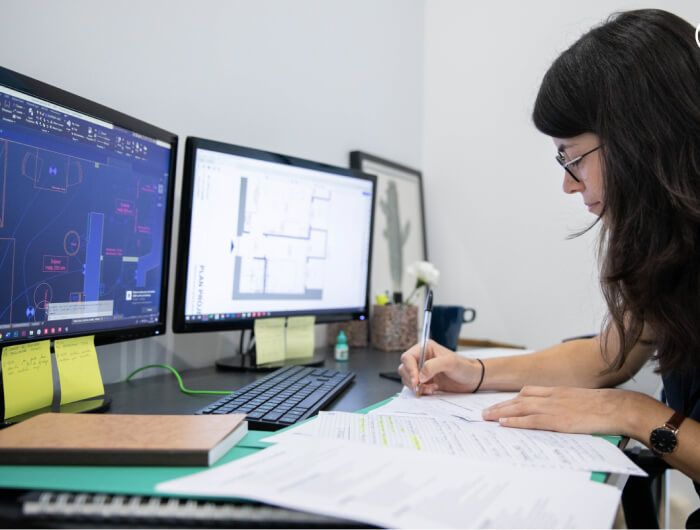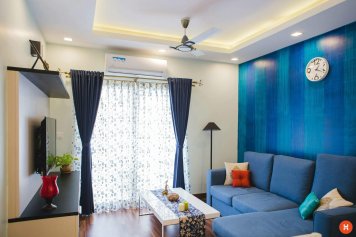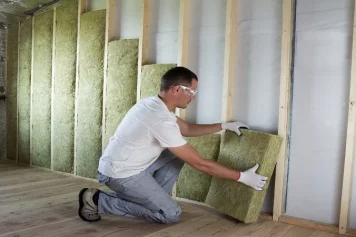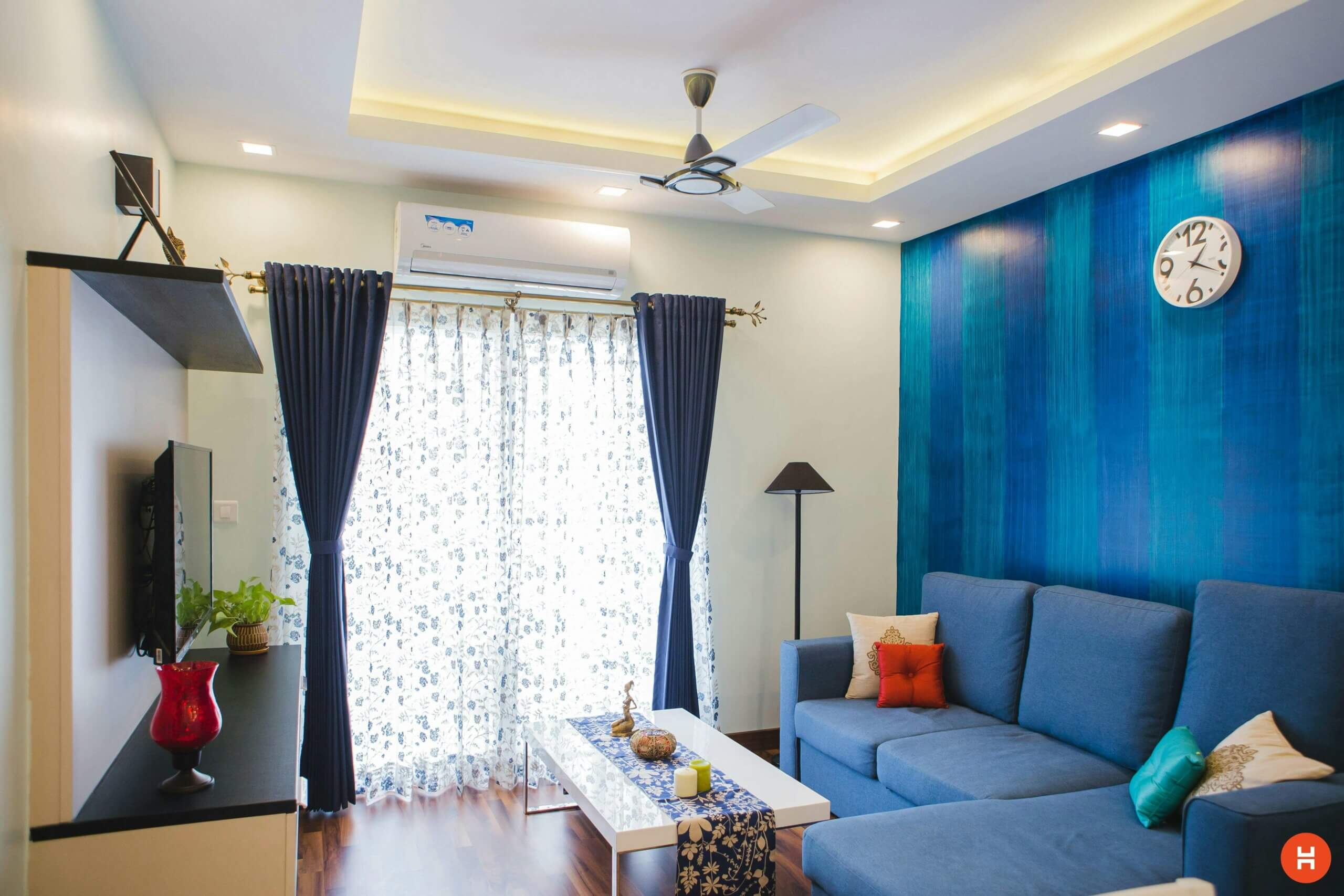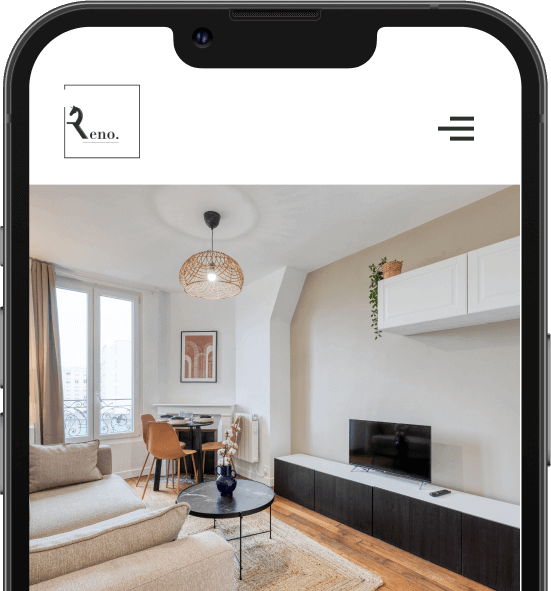Whether you’re working on one room, an entire house, or have a commercial project in mind, the right interior designer can help you achieve the best possible result. Creating an optimal layout and choosing materials, colors, fixtures, and lighting are essential to a successful project, but so are the interior designer’s project management skills , budgeting abilities, and technical knowledge.
Choosing an interior designer is a difficult task. You want everything to be perfect. After all, you’ll be living with the results for a long time, so you can’t afford to make any mistakes. That said, it’s up to you to find the right person or company for the job, and to do so, you need to follow a series of steps. For this reason, we’ve compiled a few things to consider before hiring one to help you make the right decision.
Missions of the interior designer
An interior designer designs the interior of buildings and the layout of the space , while an interior decorator focuses on the furnishing and decoration of an interior . However, interior design is a much more important task than simply making a building aesthetically pleasing . In a construction project , the interior designer must strike a balance between aesthetic and practical (functional and environmental) aspects. Interior design focuses solely on the aesthetics and furnishing of the interior .
Interior designers must consider the functionality, safety, and appearance of the building . This requires a great deal of skill and careful consideration throughout the design process. Interior designers have specialized training to accomplish these tasks, most often acquired through specialized degrees and certifications in their field.
How to decide whether or not you should hire an interior designer?
If you’ve ever moved into a new home, you may have considered hiring an interior designer. But the very idea of hiring one can be intimidating for some. Maybe you feel like your budget isn’t big enough. Or that you’ll end up working with someone who won’t understand your vision or style. Here are some tips on when to work with an interior designer and when it’s best to tackle your project alone.
You should work with an interior designer when moving into a new home.
Moving into a new home can be overwhelming. An interior designer can help you improve general elements that need updating, such as paint colors, lighting, window treatments , and floor plans. You can also use their services to help you decide which pieces from your old home to keep and their ideal placement, as well as the new pieces needed to fill the space in a cohesive and beautiful way that matches your tastes and how you want to use your space.
You should hire an architect for major renovation projects .
There are so many details to consider when undertaking a major renovation and it would be best to hire an interior designer to assist you with your renovation project .
You should work with an architect/designer for mid-level renovations.
You may not be gutting your kitchen or bathroom, but you’re doing a lot more than just buying furniture. For example, you could be installing a new countertop, choosing new cabinets, or choosing new appliances. An interior designer has a wealth of resources at his disposal.
You shouldn’t work with a designer if you want everything done in one day.
Is your goal to move into a perfectly finished home? Postpone your move-in date or reevaluate your plans. Good design takes time. Not only the selection of items, but also shipping and customizations can take weeks or even months. Issues beyond the architect’s control can arise, such as the destruction of items during shipping, delays from overseas suppliers, etc.
If you want to move into a new place with little wiggle room and have everything perfectly set up and finished, that won’t happen if you hire an interior designer . It’s probably best to go to a store that sells room sets and offers free lamps and a side table. Sure, it won’t be as pretty or have the architect’s touch, but you’ll have a comfortable place to sit. You can also rent furniture and take your time deciding what you really want.
How much does it cost: interior designer fees
Whether they charge by the hour or a fixed rate, interior designers calculate their prices in a variety of ways. Some take the size of the project into account, while others apply a commission percentage to the total cost. Either way, it’s a good idea to start by researching the different options.
Hourly rate for interior designers
This is probably the simplest way to pay interior designers. Interior designers’ hourly rates can range from $80 to $200 or more per hour. This rate structure is ideal for smaller projects with a limited timeframe. The hourly rate takes into account travel time, walk-throughs of your space, time spent shopping, email or phone conversations, or other indirect time spent on your space. However, it does not include furniture or materials.
Flat rate for interior design and decoration
Depending on the size and needs of your project, some interior designers offer a flat rate for their services. The interior designer’s contract and quote clearly state what is included in this rate, as well as the number of possible revisions and the contract expiration date (project completion date). Interior designers’ costs are often based on a flat-rate structure because it is easier to estimate the work required when there are no architectural requirements .
Monthly fees for the interior designer
In this arrangement, the interior design price is an agreed amount, paid in advance each month before the work is completed. It is important to establish a clear contract regarding the architect’s expectations (services, communication, schedules, etc.).
Commission
Instead of an hourly fee, some interior designers purchase your furniture, decor, and other supplies at a discount and then charge you the retail price, keeping the difference for their fee . Others charge a markup as a tip (usually 15%) and keep a percentage of the total cost of your furniture and supplies. Either way, it’s a good idea to get copies of receipts for purchases to confirm the amount paid. It’s also helpful to get cost estimates from the interior designer for this method to ensure your budget is respected.
Percentage
With a total budget in mind (construction, materials, etc.), it is also possible to calculate the price of an interior design . The interior designer’s fees are calculated by multiplying by a percentage of the total cost (from 10 to 15%).
The interior designer vs. the HMONP architect
What are the major differences between these two professions:
- Their area of expertise: An HMONP architect is trained to build a structure that complies with certain codes, regulations, and standards, while ensuring its functionality. An interior designer, on the other hand, is responsible for creating attractive interiors that suit the residents.
- The basic requirements they focus on: Architects focus on more technical aspects like the shape of a building , direction, materials, etc. An interior designer focuses more on aspects like human wants and needs, functionality of space , and aesthetics.
- When should you contact both? It depends on your needs. If you have a ready-made structure and need to decorate the interiors , then you should hire an interior designer . On the other hand, if you have an empty plot of land and need to build a building from scratch or renovate it , you should hire an architect with an HMONP qualification . Therefore, for a new house, you will need both professionals, one at the beginning and the other after construction is complete.
- Fees: The fees charged by both professionals are relative. Some charge a percentage of the project value , while others charge a flat fee. It also depends on the size, value, and type of project. Fees can range from 6% to 15% for both professionals. Sometimes, your architect can also provide interior design expertise , so don’t hesitate to ask!

What to choose between an interior designer and an HMONP architect?
An interior designer, as mentioned above, is a professional who carries out interior design and renovation work . He or she can work for any type of clientele, whether private individuals or professionals. This could be the interior of a house , an apartment, a shop, a restaurant, etc.
Unlike the HMONP architect , he is a professional holding a practice license , which is called Habilitation à l’exercice de la Maîtrise d’Œuvre en son Nom Propre . He can thus be registered with the order of architects after taking an oath, and has the capacity to establish architectural projects , which will be the subject of a building permit application .
So if you need to do major work requiring a permit , etc., you must call on the HMONP architect. But if it is a simple interior design or transformation, this will be the specialty of the interior designer and he will be the most recommended.
However, apart from the specific skills that an interior designer might have , you should also know that the latter is a professional who must comply with the regulations in force, which are as follows:
- Professional liability insurance ;
- The ten-year guarantee when it comes to new constructions , major renovations or various developments . This therefore covers a 10-year guarantee on the repair of any damage that occurs after the work has been completed;
- The two-year guarantee : covering equipment that can be separated from the building for two years;
- The guarantee of perfect completion . This latter guarantee concerns the repair of disorders or defects of conformity, which are identified either upon receipt or within one year after completion of the work .
Also, by hiring an interior designer, you will establish a contract under common law. The latter will be signed by both parties, the client who is the project owner and the architect who is the project manager . It will notably provide for the rights and duties of each of the parties (amount and payment of fees, completion of work, etc.) and will serve as a reference throughout the discussions until the completion of the work .
The elements to help you make your choice
An interior designer must be able to carry out work to perfection , thanks to his technical skills and his possible creativity! He must therefore have artistic talents and will have ideas to offer you on the choice of materials, on the shade of colors, the lighting, the location of the equipment, the furniture, etc. He will also be able to create custom-made furniture to adapt to the interior space .
The interior designer must also have good listening and analytical skills , as these will be the basis of his work. But beyond these skills, the architect must also master the technical aspects of carrying out the work.
For the design and decoration style side , the architect must offer you varied ideas , which must both follow new trends and at the same time master ancient arts to meet the demands of certain clients, such as vintage for example if you are a fan of old interior decorations .
Another important criterion is that your architect should be able to provide a quote or estimate as quickly as possible so that you can decide on the work to be done.
To bring all these points together, a professional in the sector will offer you a technical study of the architectural project , which will help you determine your choice:
1 – The Floor Plan
Also called a floor plan, this concept consists of presenting a 2D top view of the length and width of the room, generally representing the organization of the space , the location and orientation of all the rooms, the tracing and drawing of the walls , doors and windows. This plan is usually the most important element.
2 – Before and after the work
This involves presenting the site plan , which will show the current state of your interior, followed by the future state after the work is completed.
3- The sectional view
This is another way of representing a divided space, which will be displayed by a vertical plane and will therefore allow you to understand the general structure of the work to be carried out. You will thus have an overview of levels if there are many rooms with floors.
4- The 3D demonstration
This involves creating a 3D graphic representation of all the elements that make up each room. This will greatly facilitate understanding of the layouts to be made, and you will therefore have a complete overview of what you will end up with once the project is completed.
There will also be the sketch which will be the first graphic representation of the project, in principle preceding the preliminary draft.
Testimonial: They called on an interior designer
Hiring an interior designer is not about throwing money out the window, because it is truly important! The architect will take into account your needs, your tastes, your desires, etc., but above all this will allow you to realize your dreams and projects by studying the budget , by the ideas of creativity , etc., as testified by clients satisfied by architects:
- 《The interior designer was able to perfectly understand the expectations of my project: first purchase with a limited budget for a complete renovation of a 2-room apartment. Her professionalism, her sense of organization, the quality of her partnerships, the time she devoted to defining my needs with me, with the objective of shared decoration, contributed to the success of our collaboration. I benefit every day from her talents in my apartment! I recommend her with my eyes closed!》
- “We entrusted them with the complete renovation of a one-bedroom apartment in Nice while we were in Toulouse, with a delivery requirement of late August 2020. The deadlines were met, with a quality renovation, despite the health situation. We highly recommend them.”
- 《 ..very professional, surrounded by skilled craftsmen, completely renovated a 1960s one-bedroom apartment 500 km from our main home, while respecting the deadlines. From our first meeting, we gave her our complete trust and followed her wise advice. We are delighted. The result is beyond our expectations! A big THANK YOU!》
- “We are truly very satisfied with the work carried out in our apartment. She designed a bookcase that was exactly what we wanted, giving us sound advice, and she carefully supervised the construction of the furniture by the carpenter-cabinetmaker she had recommended to us. We are delighted to have used her skills.”
You want to become an architect: Training and studies to become an interior designer
A person who wants to become an interior designer is generally passionate about interior design, geometry, decorative arts, etc. It will therefore be necessary to really embark on relevant training to acquire more talents and skills.
The course will begin with the Baccalaureate, which will be a technological Baccalaureate STD2A
Students who are passionate about art and want to pursue it as a career are often drawn to the Science and Technology of Design and Applied Arts program. Students will have the choice between analysis and methods in design, or conception and creation in design and crafts. The latter is rather practical.
After the baccalaureate, you can continue on the interior design course . The profession can be practiced after obtaining a bac+2, but you are advised to continue to bac+4 at least to fully master the sector and obtain a diploma recognized by the CFAI. The course in this case can in particular be done in a specialized school. It should be noted that the diploma recognized by the State is not required for the profession of interior designer .
You should also know that outside of this course, with a general baccalaureate, you can aim for the following diplomas:
- Diploma in Arts and Crafts (DMA) in bac+2, with the option of housing arts/architectural decoration;
- DNA or National Diploma of Art with design option in bac+3;
- DSAA or Higher Diploma in Applied Arts with the Interior Architecture and Product Design option;
- Master’s degrees (Bac+5) from leading business schools. The list of these has already been recommended by professionals, who are members of the CFAI, FDE, CGE, Cumulus, etc. associations and networks. The advantage of following this advice will be, in particular, to have a better chance of finding career opportunities.

